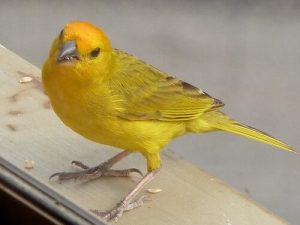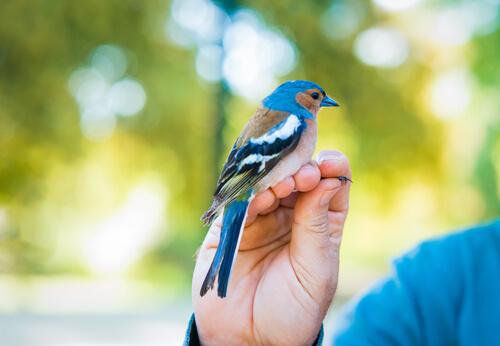How to Identify a Bird's Gender


Written and verified by the lawyer Francisco María García
Identifying a bird’s gender can be complicated. Even vets with the most expert of eyes may not be sure how to identify a bird’s gender at times. Most birds do not have obvious characteristics that reveal their sex. And it’s not uncommon for birds who were later found to be males to have been given female names.
Lab Tests: The Infallible Method
Since dogs and cats are much more popular pets, finding a veterinarian whose specialty is birds can be tough. However, if any specialist isn’t sure of a bird’s gender, they may choose the safest option: a lab test.
There are three different types of analyses:
- Blood tests: this is the most common test, but it requires a skilled professional to draw a blood sample from the animal’s legs without hurting it.
- Stool tests: taking a stool sample is much simpler than taking a blood sample. However, this test has one key limitation: it only works with adult birds.
- Feather analysis: this test is one hundred percent accurate, just like the first two. The downside to this test, though, is that not many laboratories are able to perform it.

Observation
Some birds do have identifiable characteristics that allow a person to easily determine their gender. Peacocks and roosters are good examples.
The peacock’s long, colorful tail is designed to attract females, and so the males stand out — even when their tail feathers are not splayed out. In the rooster’s case, not only does the bird’s crest give away its gender, but its powerful voice and song leave no room for doubts.
As for the parakeet, one of the most popular species of birds, their coloring above the beak tells their gender. In males, it’s blue or pink, while in females, it’s brown or white. Also, some male parrots have much brighter feathers than females.
Canaries and Other Species
The canary is another very popular pet bird. Male canaries are the ones who are constantly singing in their cages, because that’s their mating call. However, this is not an entirely accurate way of determining a canary’s gender. The hormonal changes that are typical in females when they’re in heat can make them sing a lot, too.
Regarding canaries and other species, their overall size, as well as the sizes of certain parts of their bodies, can be a sign of their gender. By taking a careful look at these aspects, you may be able to successfully identify a bird’s gender.
The males are more slender and athletic, and they sit completely upright. The dimensions and shape of a bird’s beak (for example, bigger and more pronounced) are also important identifying factors. Their legs are also larger and closer together. The females, on the other hand, are smaller and have a more rounded shape.
Another visual method that can help you identify a bird’s gender is to check the animal’s rear end. The area near the bird’s anus, on the back of its body, may or may not have a small bump. If it does, that’s a sign that the bird is probably a male.
Palpating the area with your fingers is an option if you’re still not sure. However, it’s not recommended, because you could really hurt the bird this way.
A Question of Attitude
In most cases with pet birds, the female tend to be more sociable, even around their owners. The males, on the other hand, are more aloof and seek to impose their presence at all times.

However, females stop being so docile after the mating period has passed. This also happens when their eggs are ready to hatch and they’re preparing to care for their young. Then, they defend their nest with more determination than the males.
When the bird’s offspring leaves the nest, the females get back their sweet side. Something similar happens if they are moved to a new bird cage.
Why is it Important to Know a Bird’s Gender?
Knowing a bird’s gender plays a part in raising it and taking care of it properly. Male birds should not share cages, as they will be in a continual struggle to dominate the territory. Females, in turn, may need protection during the mating season.
Main image source: Juan Tello
Identifying a bird’s gender can be complicated. Even vets with the most expert of eyes may not be sure how to identify a bird’s gender at times. Most birds do not have obvious characteristics that reveal their sex. And it’s not uncommon for birds who were later found to be males to have been given female names.
Lab Tests: The Infallible Method
Since dogs and cats are much more popular pets, finding a veterinarian whose specialty is birds can be tough. However, if any specialist isn’t sure of a bird’s gender, they may choose the safest option: a lab test.
There are three different types of analyses:
- Blood tests: this is the most common test, but it requires a skilled professional to draw a blood sample from the animal’s legs without hurting it.
- Stool tests: taking a stool sample is much simpler than taking a blood sample. However, this test has one key limitation: it only works with adult birds.
- Feather analysis: this test is one hundred percent accurate, just like the first two. The downside to this test, though, is that not many laboratories are able to perform it.

Observation
Some birds do have identifiable characteristics that allow a person to easily determine their gender. Peacocks and roosters are good examples.
The peacock’s long, colorful tail is designed to attract females, and so the males stand out — even when their tail feathers are not splayed out. In the rooster’s case, not only does the bird’s crest give away its gender, but its powerful voice and song leave no room for doubts.
As for the parakeet, one of the most popular species of birds, their coloring above the beak tells their gender. In males, it’s blue or pink, while in females, it’s brown or white. Also, some male parrots have much brighter feathers than females.
Canaries and Other Species
The canary is another very popular pet bird. Male canaries are the ones who are constantly singing in their cages, because that’s their mating call. However, this is not an entirely accurate way of determining a canary’s gender. The hormonal changes that are typical in females when they’re in heat can make them sing a lot, too.
Regarding canaries and other species, their overall size, as well as the sizes of certain parts of their bodies, can be a sign of their gender. By taking a careful look at these aspects, you may be able to successfully identify a bird’s gender.
The males are more slender and athletic, and they sit completely upright. The dimensions and shape of a bird’s beak (for example, bigger and more pronounced) are also important identifying factors. Their legs are also larger and closer together. The females, on the other hand, are smaller and have a more rounded shape.
Another visual method that can help you identify a bird’s gender is to check the animal’s rear end. The area near the bird’s anus, on the back of its body, may or may not have a small bump. If it does, that’s a sign that the bird is probably a male.
Palpating the area with your fingers is an option if you’re still not sure. However, it’s not recommended, because you could really hurt the bird this way.
A Question of Attitude
In most cases with pet birds, the female tend to be more sociable, even around their owners. The males, on the other hand, are more aloof and seek to impose their presence at all times.

However, females stop being so docile after the mating period has passed. This also happens when their eggs are ready to hatch and they’re preparing to care for their young. Then, they defend their nest with more determination than the males.
When the bird’s offspring leaves the nest, the females get back their sweet side. Something similar happens if they are moved to a new bird cage.
Why is it Important to Know a Bird’s Gender?
Knowing a bird’s gender plays a part in raising it and taking care of it properly. Male birds should not share cages, as they will be in a continual struggle to dominate the territory. Females, in turn, may need protection during the mating season.
Main image source: Juan Tello
This text is provided for informational purposes only and does not replace consultation with a professional. If in doubt, consult your specialist.








